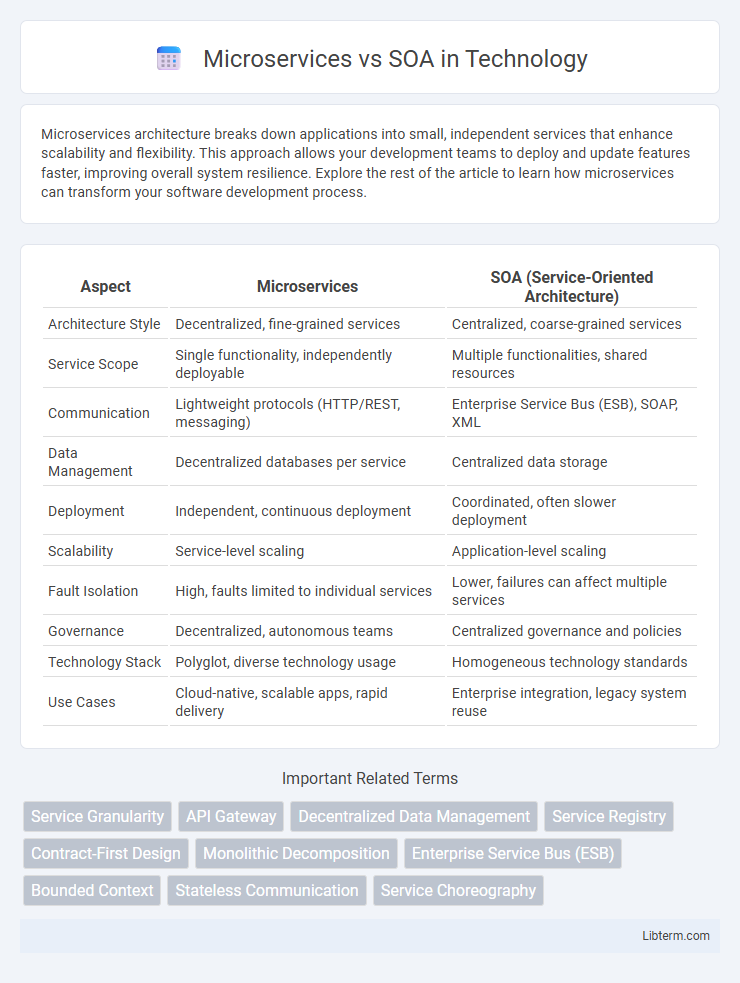Microservices architecture breaks down applications into small, independent services that enhance scalability and flexibility. This approach allows your development teams to deploy and update features faster, improving overall system resilience. Explore the rest of the article to learn how microservices can transform your software development process.
Table of Comparison
| Aspect | Microservices | SOA (Service-Oriented Architecture) |
|---|---|---|
| Architecture Style | Decentralized, fine-grained services | Centralized, coarse-grained services |
| Service Scope | Single functionality, independently deployable | Multiple functionalities, shared resources |
| Communication | Lightweight protocols (HTTP/REST, messaging) | Enterprise Service Bus (ESB), SOAP, XML |
| Data Management | Decentralized databases per service | Centralized data storage |
| Deployment | Independent, continuous deployment | Coordinated, often slower deployment |
| Scalability | Service-level scaling | Application-level scaling |
| Fault Isolation | High, faults limited to individual services | Lower, failures can affect multiple services |
| Governance | Decentralized, autonomous teams | Centralized governance and policies |
| Technology Stack | Polyglot, diverse technology usage | Homogeneous technology standards |
| Use Cases | Cloud-native, scalable apps, rapid delivery | Enterprise integration, legacy system reuse |
Introduction to Microservices and SOA
Microservices architecture breaks down applications into small, independent services that communicate via APIs, enabling rapid development, scalability, and flexibility. Service-Oriented Architecture (SOA) organizes business functions into reusable services that interact over an enterprise service bus (ESB) to promote interoperability and integration across diverse systems. Both approaches emphasize modularity, but microservices focus on decentralized governance and lightweight communication protocols, while SOA relies on centralized control and formalized service contracts.
Key Architectural Differences
Microservices architecture breaks down applications into small, independently deployable services focused on specific business capabilities, while SOA (Service-Oriented Architecture) emphasizes a centralized, enterprise-level integration of services. Microservices promote decentralized data management and communication through lightweight protocols like REST, contrasting with SOA's reliance on centralized enterprise service buses (ESB) and XML-based messaging. Scalability and fault isolation are more granular in microservices due to autonomous service deployment, whereas SOA typically involves larger, stateful services with shared resources and orchestration.
Service Granularity Comparison
Microservices architecture emphasizes fine-grained service granularity, where each service handles a specific business capability independently, enabling rapid deployment and scalability. In contrast, Service-Oriented Architecture (SOA) typically involves coarser-grained services that encapsulate broader business functions, often requiring centralized governance and shared resources. The granular nature of microservices facilitates isolated updates and technology heterogeneity, while SOA's larger service units aim for organizational standardization and integration across enterprises.
Communication Protocols in Microservices vs SOA
Microservices primarily utilize lightweight communication protocols such as REST over HTTP/HTTPS and messaging queues like RabbitMQ or Kafka, enabling asynchronous and loosely coupled interactions. SOA often relies on heavier, standardized protocols like SOAP over HTTP or JMS, emphasizing formal contracts and interoperability within enterprise environments. The choice of communication protocol in microservices promotes scalability and agility, whereas SOA protocols focus on reliability and comprehensive service orchestration.
Technology Stack Flexibility
Microservices architecture offers greater technology stack flexibility by enabling independent development and deployment of services using different languages, frameworks, and databases tailored to specific needs. SOA typically relies on shared middleware and standardized protocols, which may limit the diversity of technology choices across services. This flexibility in microservices fosters faster innovation, easier integration of new tools, and optimized performance for individual components.
Scalability and Performance
Microservices architecture enhances scalability by enabling independent deployment and scaling of discrete services, which optimizes resource allocation and minimizes bottlenecks. Service-Oriented Architecture (SOA) often relies on larger, centralized services that can restrict performance due to increased inter-service communication overhead and shared resource dependencies. Microservices typically exhibit superior performance in dynamic environments by isolating failures and improving fault tolerance, while SOA's monolithic components may encounter higher latency under heavy loads.
Deployment and Maintenance Strategies
Microservices enable independent deployment of small, self-contained services, allowing for rapid updates and minimal downtime, while SOA typically involves deploying larger, monolithic services that require coordinated releases. Maintenance in microservices benefits from isolated failure domains and continuous integration/continuous deployment (CI/CD) pipelines, whereas SOA maintenance often demands comprehensive testing across interconnected components to prevent cascading failures. Containerization and orchestration tools like Kubernetes enhance microservices deployment agility, contrasting with the more centralized governance models favored in SOA environments.
Security Considerations
Microservices architecture enforces security through decentralized authentication and authorization mechanisms, often leveraging OAuth 2.0 and JSON Web Tokens (JWT) for fine-grained access control across independent services. In contrast, Service-Oriented Architecture (SOA) typically relies on centralized security models such as WS-Security standards combined with enterprise service buses (ESBs) to govern message-level encryption and identity assertions. The distributed nature of microservices demands robust API gateway implementations and continuous monitoring to mitigate risks like token theft and inter-service communication vulnerabilities.
Use Cases and Real-World Examples
Microservices architecture is ideal for large-scale, agile applications requiring rapid deployment and independent scaling, as seen in Netflix's streaming platform enabling continuous delivery and resilience. SOA suits enterprise environments demanding complex integrations across diverse legacy systems, exemplified by banks using SOA for secure, standardized transactions between heterogeneous applications. Use cases emphasizing decoupled services with containerized deployments favor microservices, while centralized governance and comprehensive service orchestration highlight SOA effectiveness in corporations.
Choosing the Right Approach for Your Business
Choosing between Microservices and SOA depends on your business's scalability needs, team expertise, and integration complexity. Microservices offer granular, independently deployable components ideal for dynamic, cloud-native applications requiring rapid innovation. SOA provides a robust framework suitable for large enterprises needing standardized, reusable services across diverse legacy systems.
Microservices Infographic

 libterm.com
libterm.com